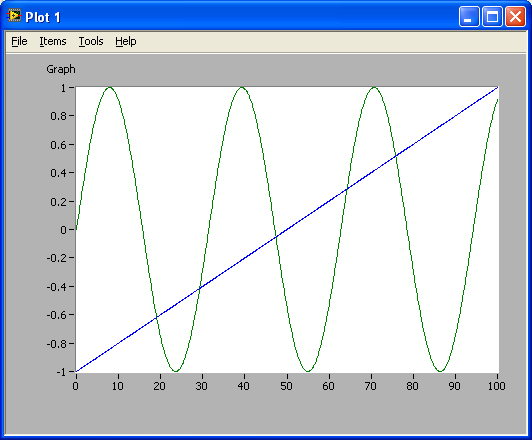
- HOW TO ADD A BOOLEAN TO A MATHSCRIPT NODE LABVIEW HOW TO
- HOW TO ADD A BOOLEAN TO A MATHSCRIPT NODE LABVIEW GENERATOR
- HOW TO ADD A BOOLEAN TO A MATHSCRIPT NODE LABVIEW SERIES
Recommended VIs: Read From Spreadsheet File.vi, Mathscript Node, Absolute Value, Index Array, Bundle, XY Graph. Make sure your VI allows you to plot the estimate in linear, semilog-y, and log-log plots. The linear output for an order of 200 should resemble this plot.

A data file - E80SampleData.txt - is available for your use and contains values of Time(s), Signal1(lb f), Signal2(g). You will want to create input nodes on your Mathscript node entitled "data" (a 2D array) and "order" (a scalar), and an output node entitled "FRF" (a 2D complex array). Investigate how the fit order influences your result, using orders that range from 200 to 1000. The PSD estimates are obtained using a curve fit approach whose fit order is a parameter you specify.

Where, and are the power spectral density (PSD) functions for each signal. m file) in a Mathscript Node to obtain Frequency Response Function (FRF, magnitude only) estimates. The help videos are While Loop Random Number Generator, and While Loop Random Number Generator.Īssignment 7 – MathScript Frequency Response FunctionĬreate a VI that uses MathScript (a MATLAB. Some recommended VIs, structures, and functions are: Case Structure, Random Number (0-1), Std Deviation and Variance.vi, RMS.vi, Build Array, Greater?, Less?, And, Array Size, Array Subset. Is it possible to make the first VI generate a list of the exact specified length with a conditional on the stop control on the while loop? Is it possible to guarantee that the array from the second VI is the exact length specified? Save them both in a common. Set the default length of the array to 100 samples.Ĭreate another equivalent VI that uses the Uniform White Noise.vi on the Signal Generation Palette to generate an array and then uses a for loop to process the array and create an output array with all of the values between 0.2 and 0.3 missing. Calculate the mean, standard deviation and root mean square of the array.
HOW TO ADD A BOOLEAN TO A MATHSCRIPT NODE LABVIEW GENERATOR
While Loop Random Number Generator For Loop Process Random NumbersĪssignment 5 – Use a While Loop and Shift RegisterĬreate a VI that uses a while loop, a shift register, and the random number generator on the Numeric Palette to generate an array of a specified length of uniformly distributed random numbers with a range of and from [0.3-1), In other words, the standard range for the random number generator but without any values between 0.2 and 0.3.

The LabVIEW Programming Assignment Due Datesįor Loop Random Number Generator Signal Generator Random Numbers The assignments will be graded on a five-point rubric scale: 5Ī VI that performs as described in the assignment description will receive a 4. They are listed in the Assignment Due Dates table below.
HOW TO ADD A BOOLEAN TO A MATHSCRIPT NODE LABVIEW HOW TO
If any assignment is taking longer than 1/2 hour, we have prepared a set of instructional videos that explain how to do the assignment. If you need assistance we recommend you watch them.
HOW TO ADD A BOOLEAN TO A MATHSCRIPT NODE LABVIEW SERIES
National Instruments has put together a series of instructional videos on LabVIEW. If your file does not have the correct naming convention, it will not be graded. For example, if I were Greg Lake in Section 4 and I was turning in Assignment 3, my file would be named Lake_G_A3_S4.llb. Your file name should be (Last Name)_(First Initial)_A(Assignment Number)_S(Section Number).(vi or llb). Our solution will be posted by Monday morning after the due date. If any assignment is taking more than 1/2 hour come see me. For all sections they are due by 5 PM in the relevant Sakai Assignment folder (one of the few actual uses for Sakai) on the date given below. The LabVIEW programming assignment are to be individual (not team) work.


 0 kommentar(er)
0 kommentar(er)
